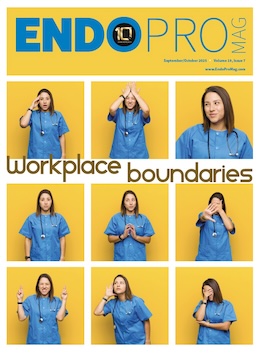The journal Clinical Gastroenterology and Hepatology has shared a new study that explores whether artificial intelligence may help with endoscopic scoring of Crohn’s disease (CD).
Endoscopic scoring of CD is challenging because mucosal disease is patchy with highly variable morphology, size, and severity. Computer vision may help quantify disease activity with similar performance as standard instruments like the Simple Endoscopic Score for Crohn’s Disease (SES-CD), according to the study abstract.
Colonoscopy videos from the STARDUST and SEAVUE phase 3 clinical trials underwent post-hoc computer vision endoscopic (CVE) assessment to quantify CD mucosal ulceration and injury. A segmentation model was trained on hand annotations of images performed by two gastroenterologists, predicting ulcer area, severity, and relative size.
Predicted ulceration and general mucosal injury were then spatially mapped to the ileum and colon to quantify CD burden. CVE ulceration and general injury values were compared to the SES-CD in terms of disease quantification, localization, and agreement with end-of-study clinical remission.
Ulcer semantic segmentation models matched the performance of gastroenterologist annotators, with neither performing better on qualitative review of disagreements. CVE measures were highly correlated with SES-CD scores, though there was expected poor correlation with the degree of stenosis.
The conclusion was that CVE “provides a means for automated ulceration and mucosal injury quantitation that shows conceptual agreement with SES-CD and offers new capabilities to improve the granularity and personalization of endoscopic disease assessment in CD.”
To read more of the study, click here.
AUSTIN, Texas—Health Tech Academy recently introduced a fully online endoscopy technician program designed to launch students into the growing field of GI healthcare. Created in partnership with clinical experts, this program focuses on real-world skills such as patient prep, scope care, sterilization practices, and procedure room support.
The six-week curriculum blends on-demand learning with live coaching sessions, allowing students to train on a flexible schedule while receiving professional guidance. Open to anyone with a high school diploma or GED, the program helps learners build confidence and competence for support roles in hospitals, outpatient clinics, and endoscopy centers.
The structured weekly curriculum covers key topics such as endoscope processing, patient safety, anatomy of the digestive system, infection prevention, and procedural assistance—taught by experienced industry professionals. Health Tech Academy (HTA) created its endoscopy technician certification program to prepare future healthcare workers with the technical skills, clinical knowledge, and patient-focused mindset needed to support today’s GI care teams.
“We’re excited to introduce a program that opens doors for students to enter the field of endoscopy with confidence,” said Shamsah Noorani, CEO of Health Tech Academy. “In just six weeks, learners can gain the hands-on knowledge and technical foundation needed to pursue certification and step into essential roles on GI care teams. Our goal is to make healthcare training more accessible—while preparing students to have an immediate, positive impact in clinical environments.”
Health Tech Academy’s program connects students with seasoned healthcare professionals who bring real-world experience from GI clinics and hospital settings. Through one-on-one mentorship and expert-led support, learners receive the kind of personalized guidance rarely found in traditional education models. The program emphasizes skill-building in a low-pressure, flexible environment that adapts to each student’s pace and needs. With streamlined coursework, prompt feedback, and an all-inclusive tuition that covers learning materials and certification prep, this online pathway offers an accessible, career-focused alternative to conventional training programs.
“Our new Endoscopy Technician program equips students with the technical training, guided mentorship, and job-ready skills needed to thrive in GI healthcare settings,” said Danish Khan, Product Manager at Health Tech Academy. “From the engaging online modules to personalized career planning tools and our career evaluation assessment, every part of the program was built to address workforce needs and prepare learners for in-demand roles in endoscopic care.”
This new Endoscopy Technician program joins Health Tech Academy’s growing lineup of career-focused healthcare certifications, which includes training for medical assistants, sterile processing technicians, and more. Each program is built for flexibility, speed, and accessibility—offering a streamlined path into healthcare without the expense or timeline of a traditional degree.
Cedars-Sinai’s upcoming Sept. 13 conference on Women and Inflammatory Bowel Disease (IBD) will highlight women’s unique experiences with the disorder and provide relevant information and guidance for both patients and providers, says gastroenterologist Puja V. Khanna, MD, the clinical director of the Cedars-Sinai Inflammatory Bowel Disease Women’s Health Program.
“In the morning, we will host a clinician track on best practices for treating women with IBD,” Khanna said. “In the afternoon, patients and families are invited to a dedicated session covering pregnancy, fertility, nutrition, mental health and more. There is also time for patients and providers to connect.”
An estimated 3 million people in the U.S. have inflammatory bowel disease, according to the Centers for Disease Control and Prevention. The disorder produces chronic and often destructive inflammation in the digestive tract. The two most common forms of IBD are Crohn’s disease and ulcerative colitis. While some cases can be mild and manageable, many IBD patients are faced with a constellation of health problems including severe diarrhea, malnutrition, dangerous blood clots, and extensive and painful scarring.
IBD occurs in men and women at about the same rate, but the disease can leave women facing unique health challenges. There can be difficult decisions about proceeding with certain drug therapies while trying to conceive or during pregnancy and menopause.
“For women living with IBD, simply knowing that their needs are recognized and that there is a community and program designed for them can be incredibly empowering,” Khanna said
The Cedars-Sinai Newsroom interviewed Khanna about how IBD impacts the health and wellbeing of women, including finding a good healthcare provider and effective therapies available to them.
In what ways can IBD impact women and men differently?
While inflammatory bowel disease occurs at about the same rate in both sexes, women often present differently. After age 30, Crohn’s disease is more common in women than in men. We also see sex-specific patterns: Women are more likely to have Crohn’s limited to the colon, less extensive ulcerative colitis, and more frequent extraintestinal conditions, such as eye inflammation and skin disorders. Recognizing these differences is critical for timely diagnosis and effective management.
Are there differences in diagnosis, disease course or treatment protocols for women?
The diagnostic workup for IBD is the same regardless of sex and typically involves colonoscopy, imaging, lab testing. However, the course of the illness can vary. Women may experience flares around hormonal changes, such as those occurring during menstruation or pregnancy.
Treatment approaches are generally the same for men and women, but side effects can differ. For example, women are more likely to develop drug-induced lupus with certain biologic therapies. Providers must stay alert to sex-based responses to various treatments for IBD. For women of childbearing age, therapy selection must consider whether a medication is safe in pregnancy. Most of them are, but not all.
Does IBD impact a woman’s reproductive life, including menstruation, fertility and pregnancy?
Absolutely. Many women report worsening symptoms during menstruation due to hormone fluctuations. Fertility can be reduced in women with active inflammation or prior pelvic surgery, although more research is needed on that front. Pregnancy outcomes are best when disease is in remission for at least three to six months before conception. Interestingly, we have found that some women with IBD may actually experience improvement in symptoms during pregnancy.
Most IBD medications can be safely continued during pregnancy, particularly when the disease is under control. Methotrexate, an immunosuppressant medication, should be avoided. There are other classes of medications, such as JAK inhibitors, whose safety and use should be discussed with your provider. At Cedars-Sinai, our IBD Pregnancy and Fertility Clinic brings gastroenterology and obstetrics together so women receive coordinated care.
Do women find it challenging to get an accurate IBD diagnosis? What advice would you offer?
Many women do face delays. They may see multiple providers before reaching a gastroenterologist who recognizes their symptoms as inflammatory bowel disease. My advice is to advocate for yourself. If you are not being heard, seek a second opinion, ideally at a dedicated IBD center. A colonoscopy and appropriate testing are essential to confirm the condition.
How do IBD patients benefit from a multidisciplinary approach to care?
One young woman in her 20s came to me after years of aggressive Crohn’s disease. She had seen specialists across the country, endured multiple treatments, and was facing another surgery. She broke down in tears, telling me she felt abandoned by her doctors. I reassured her and then brought her case to our weekly IBD meeting where top experts could collaborate on her care. That sense of not being given up on, and of building a trusted partnership with a care team, can be life-changing for patients living with a chronic illness.
The Women and IBD conference will take place at Cedars-Sinai on Saturday, Sept. 13. Attendance is free but registration is required.
Those interested in attending can email [email protected] to register and receive more information.
A team from Helmholtz Munich, the Technical University of Munich (TUM), and the Medical University of Vienna has introduced a new imaging approach known as oxygen-enhanced endoscopy (O2E), which enables highly precise detection of cancerous lesions in the esophagus. According to research published in Nature Biomedical Engineering, this technique can reveal even subtle pathological alterations in tissue, paving the way for earlier identification and diagnosis.
O2E merges optical coherence tomography—which provides detailed images of tissue architecture—with optoacoustic imaging, a method that employs light pulses and ultrasound to visualize tiny blood vessels in deeper tissue layers. By combining these two technologies within a single capsule that rotates to scan the entire esophagus, O2E delivers high-resolution, three-dimensional images of the esophageal lining.
Researchers tested the O2E system in a pilot study by examining both animal esophageal tissue and human samples from individuals with Barrett’s esophagus, a condition that can precede esophageal cancer. The team successfully distinguished healthy tissue from areas with abnormal cell changes, precancerous developments, and cancerous growths. Additionally, they conducted proof-of-concept tests on the inner lip of a volunteer, taking advantage of its comparable tissue features.
Use Them to Decrease Distraction and Increase Joy
You’re having a very busy day with many patients on the schedule. You’re documenting information regarding a patient you just interviewed. During your hectic day, a co-worker approaches you says, “I don’t think I will have time to finish these calls; could you call these patients?” This same co-worker has periodically asked you to complete tasks that they are responsible for in the workplace. Despite having a full plate of tasks, you agree to help your co-worker.
In the above workplace scenario, what just happened? You think you’re helping a co-worker, but this person is repeatedly asking you to do their work. What is happening is a violation of boundaries. Of course, filling in to help a co-worker is fine, but when it becomes habitual, then it’s an issue.
Editor’s Note: The following package deals with setting boundaries in the workplace, such as boundaries with colleagues, bosses and patients, and against noise and distractions. Boundary-setting is more important than ever, because modern medical settings are more stressful than perhaps ever before, with the exceptions of say, COVID, or times of war. We have limited control over the workplace, but the following articles focus on where improvements might be possible.
What is a Boundary?
A boundary is a limit defining you in relationship to someone or to something. Boundaries can be physical and tangible or emotional and intangible. For example, a physical boundary is a fence, which identifies spatial limitations. Physical boundaries are concrete and easily identifiable. However, emotional boundaries are much less clear, which can make them more challenging to establish and enforce.
A line in the sand is a clear physical boundary. When a person steps over that line, they have violated the boundary. This same analogy can be used in emotional boundaries as well. For example, if a co-worker makes an inappropriate comment, they have crossed a line.
Having effective boundaries will not distance you from others. The boundaries prevent conflict and bring people together because, generally speaking, everyone knows what acceptable behavior is. This article will help you establish boundaries while still maintaining excellent relationships with co-workers.
 Causes of Boundary Violations
Causes of Boundary Violations
Emotional Baggage
Everyone enters the workplace with some baggage. When people walk into the workplace, they do not leave their baggage by the door. Baggage brought into the workplace can affect interactions with coworkers, potentially leading to significant issues with boundaries. Many factors come into play, including the style of communication each person experienced in their families. Some people come from family situations where nurturing relationships were seen and modeled. Unfortunately, other people come from situations where significant dysfunction was present, and those styles of behavior walk into the workplace. Some people don’t realize they are violating boundaries in their communication style because in their environment, such behavior was acceptable.
Presenteeism
This term means that employees are physically present, but due to physical or emotional issues, are distracted to the point of reduced productivity. While absenteeism means they are physically absent, presenteeism means they are physically present, but due to other issues they are unable to function effectively to complete work-related assignments.
Many of the causes of presenteeism are rooted in psychological issues. For that reason, the workplace needs to have tools to help struggling employees, including stress-management support and, when needed, employee assistance programs. The privacy and confidentiality of such programs must be fiercely guarded—from both other employees and management—or employees will not feel comfortable using them.
Presenteeism leads to weak interpersonal relationships. Combining emotional baggage and presenteeism can lead to workplace toxicity and exacerbate the ensuing boundary violations.
 Types of Boundaries
Types of Boundaries
Co-worker Boundaries
Everyone in the workplace has job responsibilities and duties. In the example above, an employee was violating a co-worker’s boundaries by continually asking them to do their work. However, boundaries may not be directly related to job responsibilities. For example, a co-worker who often uses crude language or tells inappropriate jokes is also violating boundaries. This employee is violating the boundaries of people who expect the workplace to be free of bawdy language and tasteless or insulting remarks.
Patient Boundaries
There are appropriate interactions with patients, and then there are behaviors that cross the line, such as talking to patients about personal issues. Of course, chatting with patients about pets or a new restaurant in town is acceptable, but talking to patients about an abusive boyfriend is not appropriate.
Setting Boundaries
The following will help with the mechanics of boundary setting.
Follow the ABC Rule
ABC = Always Be Courteous. A person can still be friendly while setting boundaries. For example, in my work as a keynote speaker and workshop leader, the person who introduces me sets boundaries regarding mobile phones, and they’re always pleasant about it.
They kindly advise the audiences to please put their phones on vibrate. There’s no need to yell at people about the volume of their phones.
Identify Your Limits
The first step in setting boundaries is determining your limits, which can be emotional, mental, physical or spiritual. You set limits by noticing what you can tolerate and accept, as well as what makes you feel uncomfortable and stressed. These feelings will help you clarify your limits. Your limits are personal and are likely to be different than the limits of other people.
In one of my many boundary-setting workshops, an attendee mentioned a co-worker who had a habit of eating her lunch in front of her computer. The problem is that she liked eating fish and some co-workers thought the smell of the food was bothersome. A co-worker politely mentioned to this person the fish issue. The fish-eating co-worker immediately apologized and mentioned having no idea of the food having a strong odor.
Overall, listen to your feelings; they will tell you if boundaries have been violated. There are certain feelings that often signal boundary violations, including feelings of discomfort, resentment or guilt. These feelings are symptoms of boundary violations.
Clarity
Workplace boundaries must be clearly outlined so people in the workplace know what behaviors are acceptable. Each team member understands what to do, how to do it, and when to do it. This creates an efficient workplace environment. Managers must define and enforce the boundaries.
 Passive-Assertive-Aggressive Behavior
Passive-Assertive-Aggressive Behavior
Passive Behavior
Passive people are submissive and sometimes have feelings of low self-esteem. They do not stand up for themselves and are often sometimes referred to as doormats, in that other people can step all over them. Since some passive people feel powerless, they may have weak or nonexistent boundaries. They focus on the needs of other people. Even if they’re really busy, if a co-worker asks them for help, they will relinquish their own responsibilities to do someone else’s work.
Aggressive Behavior
Aggressive people are sometimes arrogant and may have unrealistic feelings of self-importance. Some belittle others and attack those who don’t share their views. Some aggressive people are tyrannical and have poor boundaries, since all their attention is on themselves. They focus only on their needs. If a co-worker asks them for help, they may refuse and be unpleasant.
Assertive Behavior
Assertive people are confident and self-accepting. These people have clearly defined boundaries. They focus on meeting their needs and the needs of others in a harmonious fashion. If they’re very busy and a co-worker asks them for help, they will politely explain that they can’t help now but will give them options to help meet their needs, such as checking back later or suggesting another person who might be able to assist.
Assertive people are comfortable and confident with themselves and have well-defined boundaries. The ideal workplace scenario is to have as many assertive people as possible since these types of individuals create a friendly and productive workplace. See Table 1 for a summary of passive, assertive and aggressive behaviors.
Handling Boundary Violations
Language
I suggest using “I” language and avoiding “you” language. “You” language can sound threatening, while “I” language comes across as pleasant, yet firm. For example, let’s say you have been asked to do excessive work and you’re feeling overwhelmed. These are two possible responses:
- “You” version: “You’re giving me too much work. You have to stop this!”
- “I” version: “I’m feeling overwhelmed. Let’s talk about solutions to manage the workflow.”
The “I” language version focuses on the sender’s feelings and is not accusatory. The response also blends in a solution-oriented perspective.
I also suggest avoiding “why” language. For example, a co-worker has not been completing assigned tasks. You have been forced to cover for this person and you’re feeling frustrated. You have reached a point where you have to say something. These are two possible responses:
- “Why” version: “Why aren’t you getting your work done?”
- “What” version: “What’s going on that’s leading to your assignments not being done? I notice this has been happening more often. Let’s talk about the situation.”
The “what” version is more friendly. The response also blends in a solution-oriented perspective.
Get It in Writing
There should be clearly written guidelines for employee job-related tasks and guidelines for interpersonal behavior to avoid boundary violations. Having clearly written guidelines moves the conversation from subjective to objective.
Two-Way Street
If you want people to respect your boundaries, then you must respect their boundaries. Be conscious of what you are asking of others. Is it reasonable?
Balance
We want clearly defined boundaries, but we must also allow for some flexibility. Our boundaries may need to vary based on the situation.
Get People Back on Track
People sometimes get distracted and go on tangents and need help getting back to the task at hand. The details of your co-worker’s vacation may be fun, but excessive discussions can take away from job responsibilities, hence violating your boundaries of completing assignments. In this situation, it’s important to respond gracefully, such as by saying, “Your vacation sounded wonderful. I need to complete this documentation, but let’s chat at lunch and you could fill me in more.”
Boundaries with Patients
Healthcare professionals must use caution when talking to a patient about their personal lives. The patient’s role is not to be that of a counselor. Only share limited and general information about life outside the workplace. However, some information can be shared if there is a benefit to the patient, such as an encouraging statement. If you had the same medical issue and are doing well, that type of discussion is certainly acceptable.
The actions of patients trigger emotional reactions among professionals. These feelings include sadness, anger and protectiveness, among many other feelings. It is normal to feel such emotions, but caution must be used in how these feelings are expressed. Emotional reactions can interfere with boundaries, including becoming too attached to certain patients while ignoring others. Becoming aware of these emotional reactions is the first step to looking at how they affect working with patients.
Terms of Endearment. Using terms of endearment can initially appear to be a gentle and kind gesture but can create issues. Calling a patient “sweetie” or “honey” may appear to be comforting to that patient, but it may also suggest a more personal interest than intended. It might also suggest favoritism to other patients who are not called by those nicknames. Some patients may find such endearments offensive or patronizing.
It is a good practice to avoid using these terms, as doing so could blur the clarity of a professional’s role in the life of the patient.
Burnout. Caregivers must learn to care for themselves. Providing care to frail and vulnerable patients is deeply rewarding, and sometimes deeply draining. The kind of giving that leads to burnout tends to involve behaviors done outside of the boundaries of one’s job. Being aware of the boundaries of one’s role and striving to adhere to those boundaries helps protect the caregiver from the destructive impact of burnout.
Gifts and Favors. Giving gifts to a patient or receiving gifts from a patient can blur the line between a personal relationship and a professional one. Have written guidelines for employees to determine what is acceptable as a gift. The same rules apply to favors, such as staying after work hours to “do a favor” for a patient.
Secrets. Do not keep secrets with patients. Do not share personal secrets with a patient and ask them to keep it a secret. Do not agree to keep secrets patients tell you. Secrets are different from confidentiality. Confidential information is shared with a few other members of a team providing care to a patient. Personal secrets compromise role boundaries.
Putting It All Together
Boundary issues will always be a part of the workplace due to a variety of factors, such as the communication skills and personal histories people bring into the workplace. A healthcare environment is a therapeutic milieu. To keep the environment therapeutic, boundaries must be established and implemented.
Through the strategies discussed in this article, you can minimize boundary issues. When equipped with the right set of skills, you can set boundaries while simultaneously creating positive workplace relationships that will benefit both your co-workers and your patients.

Author
-

Edward is the founder and director of the Center for Healthcare Communication, a consulting firm helping healthcare professionals effectively communicate with patients and each other.
View all posts














